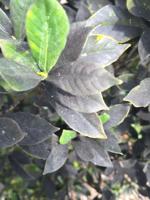
Timely landscape chores include pest control and repotting | Home/Garden
For gardeners awaiting fall planting weather, there are still plenty of chores to do.
I sure am ready for some cool fronts to make their way through the state and relive the heat and humidity. In the meantime, there are a few things we need to keep up with in the landscape.

Sooty mold is a sympton of white fly infestation.
Eliminate whiteflies
One of the worst insect pests of late summer is the whitefly, a snow-white insect a little bigger than a gnat. Clouds of them will fly up from a heavily infested plant when it is shaken. Both the adults and the immature whiteflies feed on the plant by sucking the sap from the foliage.
Infested plants will have a sickly appearance and dull leaves. A black deposit called sooty mold often appears and leaves may turn yellow and fall off. Sticky leaves and sooty mold may also indicate other sucking insects, such as scale, aphids and mealybugs. You may control them using the same control methods as those used on whiteflies.
Whiteflies often infest hibiscus, Confederate rose, lantana, mallow, poinsettia, gardenias, citrus and some bedding plants. Many vegetables in the garden now are susceptible to whiteflies, including tomatoes, eggplant, okra and sweet potatoes.
Controlling whiteflies can be difficult, especially when the population levels get high. On ornamentals you can use malathion, light horticultural oils or bifenthrin. Spray thoroughly under the leaves. Systemic insecticides like acephate, imidacloprid or dinotefuran are also effective.
In the vegetable garden and on fruit trees (citrus are prone to whiteflies), a light horticultural spray (Year Round Spray Oil, All Seasons Spray Oil) is an organic option that is effective. Be sure to spray thoroughly under the leaves following label directions. When daytime highs are in the 90s, spray during the cooler early morning hours.

Pine straw makes a great mulch — especially if you have pine trees and can get it free.
Renew mulches
Mulches in beds around shrubs have typically decayed and thinned out over the summer, especially if you watered a lot. Once the layer of mulch gets thin, it no longer does a good job of controlling weeds.
It’s a good time of year to check the thickness of mulches in beds around shrubs, flowers and vegetables to make sure it is still thick enough. Around bedding plants and vegetables, the mulch should be at least one inch and preferably two inches. Around shrubs, mulches should be two to three inches, and around trees the mulch should be about four inches.
Replenish mulch layers with fresh material to maintain the appropriate thickness. Simply spread the new mulch over the old mulch. Ideally, use what you can get for free — such as leaves (chopped or whole), dry grass clippings or pine straw. If you prefer the appearance of a purchased mulch, put down a one- or two-inch layer of something free (leaves, dry grass clippings or pine straw), and then topdress with one inch of your favorite purchased mulch. This will save you money and still give you the look you like.
You may see mulch piled deeply in a cone shape around the trunks of trees. This has been termed “volcano mulching” and is to be avoided. Mulching deeply around the base of the trunk can cause a variety of problems for the tree.
Repot container plants
September and early October are ideal for repotting tropical container plants that you have summered outdoors. Their abundant growth during summer may mean they are pot-bound now.
Because many plants undergo some shock after repotting, a period of gradual adjustment should be allowed before they are moved indoors for the winter.
They should be left where environmental conditions do not place great demands on their systems. Shaded porches, patios and terraces or areas beneath the canopy of shade trees usually are best for getting plants over the trauma to their roots that may occur from repotting.
Frequency of repotting depends on the plant, condition of the potting mix, container size and the growth rate of the plant. Look for roots growing out of the drainage holes. Or turn the pot on its side and gently slide the plant out of the pot. A solid mass of packed roots means it’s time to repot.
Most nurseries and garden centers have prepared mixes for container plant culture. Make sure that the mix has a loose, fluffy texture instead of a fine, heavy texture so that it will drain well.
Fertilize repotted plants after three to four weeks. Use a water-soluble plant fertilizer and follow manufacturer’s directions.

IO moth caterpillar
Get rid of stinging caterpillars
Stinging caterpillars are often around in the landscape in late summer, feeding on a variety of plants. Keep an eye out for the tan, furry puss moth caterpillar; the square-shaped, brightly colored saddleback caterpillar; and the green, spiny IO moth caterpillar.
These caterpillars produce a very painful burning, itching sting when touched. Children should be cautioned against touching any caterpillar.
Stings most commonly occur on hands or arms as gardeners work among their shrubs. Wearing gloves and long sleeves will help prevent stings. To control these pests, physically destroy as many as you can see. Then, spray the plants with BT, spinosad, carbaryl, bifenthrin or permethrin.
The LSU AgCenter has an excellent online publication with color pictures and information on all the stinging caterpillars here in Louisiana. Do an internet search using — LSU AgCenter stinging caterpillars — and click on the link.



